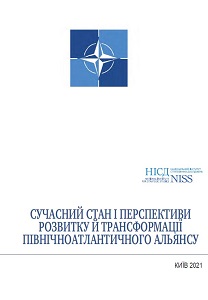Сучасний стан і перспективи розвитку й трансформації Північноатлантичного альянсу
Current State and Prospects of Development and Transformation of the North Atlantic Alliance
Author(s): V. Kravchenko, Vasilij Orlik, Mykola Zamikula, Vladimir Yarmolenko, O. Davimuka
Subject(s): Security and defense, Military policy, Peace and Conflict Studies
Published by: НІСД Національний інститут стратегічних досліджень
Keywords: 1991 NATO Rome Summit; Partnership for Peace; 1997 NATO Madrif Summit;
Summary/Abstract: The process of transforming the Alliance's role and status in the new context of regional and global security was launched by NATO's Rome Summit in 1991. The abolition of the Warsaw Pact and the collapse of the Soviet Union marked the end of the Cold War in global scale. The 1991 Strategic Concept of the Alliance focuses on changing the geopolitical balance and expanding the Euro-Atlantic security space (given the transformations that have taken place in Central Europe). A decision was reached to strengthen NATO's political role and the functioning of the Alliance based on the principles of collective defense, dialogue and cooperation (in particular, to promote reforms in the former socialist camp and launch new formats of interaction with other players in Central and Eastern Europe). // Among such formats, the Partnership for Peace initiative, which was decided at the NATO summit in Brussels in 1994, played a special role. During the NATO Summit in Madrid in 1997, the Charter on a Distinctive Partnership between Ukraine and the Alliance was signed, which regulates the format of cooperation between the parties at the political level. The summit announced NATO's first eastward enlargement to include Poland, the Czech Republic and Hungary, as well as the launch of a policy of Alliance enlargement to include the former Warsaw Pact and the former Soviet Union.
Series: Аналітична доповідь
- Print-ISBN-13: 978-966-554-330-5
- Page Count: 36
- Publication Year: 2021
- Language: Ukrainian
- eBook-PDF
- Table of Content

